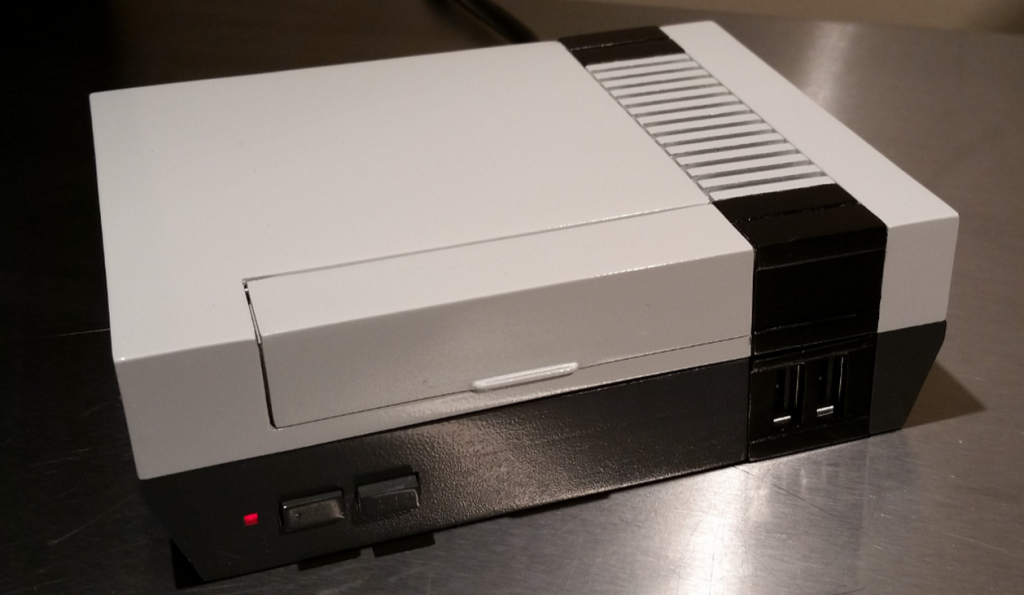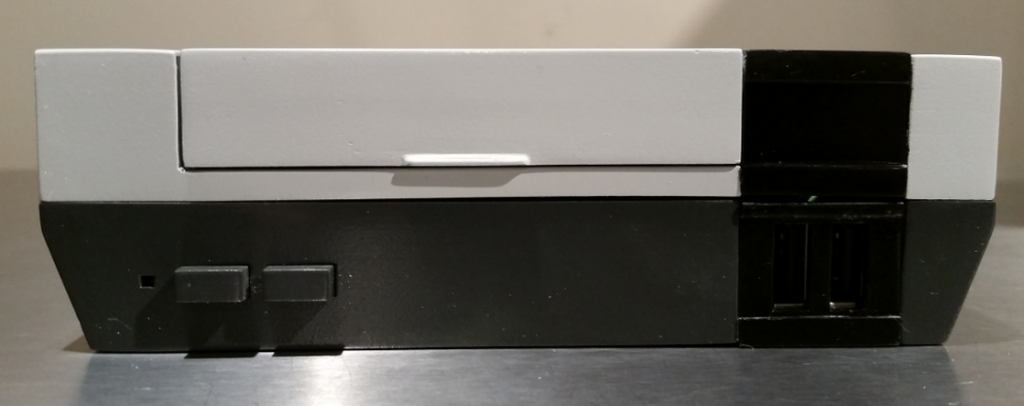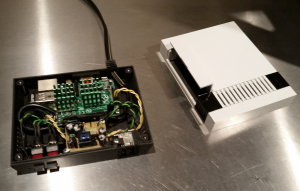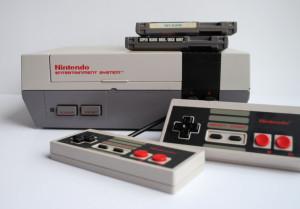While it certainly wasn’t the first home game console, the Nintendo Entertainment System is probably the most recognizable, even 30 years after it was first released in the United States. In its lifetime, the NES sold almost 62 million units all over the world and revitalized a video game industry that had seen several years of sagging sales. One of the main features often attributed to the massive success of the NES was the design of the case. It was made to look similar to other home electronics, with the front-loading cartridges being reminiscent of a VCR. And Nintendo was very careful to not treat it like a toy and emphasized that video games were for everyone, not just children. In a lot of ways the release of the NES was the moment that video games started to grow up.
Originally intended as a Christmas gift, Thingiverse user T.J. Owens’ Raspberry Pi B+ Mini Classic NES case project turned out to be a lot more of a complex build that he had originally intended. When he went looking for a mini version of the NES he wanted it to be as close in appearance as possible while also not being any larger than it needed to be. Unfortunately, what he found was either needlessly big, had the ports in the wrong places or just didn’t look enough like the original. So Owens decided to simply build his own mini NES that would be custom built around the newest model of the Raspberry Pi and designed to be as accurate as possible. Similar to a 3D printed mini-NES we saw back in April, Owens’ project is inspired by the RetroPie Project–“it’s the purpose of the case after all,” he tells us.
 Other than the size, Owens made a real effort to make his version of the NES true to the original console’s appearance and aspect ratios. He designed the model in Blender, using photo references and a set of calipers to make sure that the dimensions and parts were all in the correct place. Then he used a 3D model of the Raspberry Pi B+ that he found on Thingiverse as reference to ensure that there would be plenty of room for it inside of the 3D printed case. However, in order to get the port placement to be accurate, Owens needed to do some customizing of the Raspberry Pi layout, so anyone looking to build their own will need to be willing to do some soldering.
Other than the size, Owens made a real effort to make his version of the NES true to the original console’s appearance and aspect ratios. He designed the model in Blender, using photo references and a set of calipers to make sure that the dimensions and parts were all in the correct place. Then he used a 3D model of the Raspberry Pi B+ that he found on Thingiverse as reference to ensure that there would be plenty of room for it inside of the 3D printed case. However, in order to get the port placement to be accurate, Owens needed to do some customizing of the Raspberry Pi layout, so anyone looking to build their own will need to be willing to do some soldering.
 While there are several large components to the design, Owens intentionally printed most of the parts separately. Not only would smaller parts be easier to print, but they would look way better when completely painted. The parts should be printed with a 100 micron resolution with a 15% to 20% infill for the best results. The parts shouldn’t need to have any supports, but be careful of the larger parts pulling up off of the printing bed. He also recommends that the heated bed be cleaned really well before printing so everything stays firmly in place. Owens recommends using PLA to print the NES case, and there will be some post processing work needed before the parts are painted.
While there are several large components to the design, Owens intentionally printed most of the parts separately. Not only would smaller parts be easier to print, but they would look way better when completely painted. The parts should be printed with a 100 micron resolution with a 15% to 20% infill for the best results. The parts shouldn’t need to have any supports, but be careful of the larger parts pulling up off of the printing bed. He also recommends that the heated bed be cleaned really well before printing so everything stays firmly in place. Owens recommends using PLA to print the NES case, and there will be some post processing work needed before the parts are painted.
“I use PLA because of its dimensional stability and waffle smell. I finished the print by wet sanding and priming with a plastic compatible primer.. light wet sand again and spray paint. I normally use Krylon fusion for my projects but this time there were no colors close to NES grey available,” Owens told 3DPrint.com.
 Owens is very clear that this is not a project for a beginner, it will require some basic electronics knowledge and there are a lot of internal components that will need to be sourced. But if you’re an old school gamer and looking for something that is a bit of a challenge, this may be the ideal project for you. Thankfully Owens has included detailed assembly instructions and a full list of the electronic required components and parts up on Thingiverse. Once the project is complete, all of the switches, lights and ports are all in the correct places, and it is almost impossible to tell that this isn’t the real thing.
Owens is very clear that this is not a project for a beginner, it will require some basic electronics knowledge and there are a lot of internal components that will need to be sourced. But if you’re an old school gamer and looking for something that is a bit of a challenge, this may be the ideal project for you. Thankfully Owens has included detailed assembly instructions and a full list of the electronic required components and parts up on Thingiverse. Once the project is complete, all of the switches, lights and ports are all in the correct places, and it is almost impossible to tell that this isn’t the real thing.
Up next for the artist and programmer is extending the design to make it even more accurate to the original. Owens has plans to create miniature NES cartridges that will fit inside of the console. The game cartridges will have NFC tags embedded inside of them so they will automatically launch specific games when inserted. You can read more about T.J. Owens on his Thingiverse profile and see his other projects over on his website Ferreusveritas.com.
Will you be creating this little video game console? Let us know in the 3D Printed NES forum thread on 3DPB.com.
Subscribe to Our Email Newsletter
Stay up-to-date on all the latest news from the 3D printing industry and receive information and offers from third party vendors.
You May Also Like
Gorilla Sports GE’s First 3D Printed Titanium Cast
How do you help a gorilla with a broken arm? Sounds like the start of a bad joke a zookeeper might tell, but it’s an actual dilemma recently faced by...
Nylon 3D Printed Parts Made More Functional with Coatings & Colors
Parts 3D printed from polyamide (PA, Nylon) 12 using powder bed fusion (PBF) are a mainstay in the additive manufacturing (AM) industry. While post-finishing processes have improved the porosity of...
$25M to Back Sintavia’s Largest Expansion of Metal 3D Printing Capacity Since 2019
Sintavia, the digital manufacturing company specializing in mission-critical parts for strategic sectors, announced a $25 million investment to increase its production capacity, the largest expansion to its operations since 2019....
Velo3D Initiates Public Offering in a Bid to Strengthen Financial Foundations and Drive Future Growth
Velo3D (NYSE: VLD) has been among a number of publicly traded 3D printing firms that have attempted to weather the current macroeconomic climate. After posting a challenging financial report for 2023,...
































